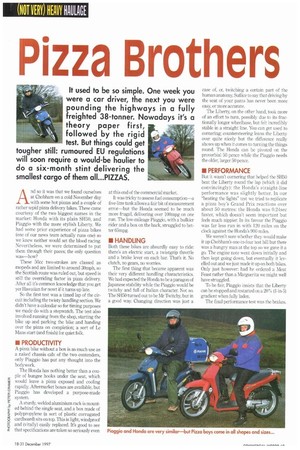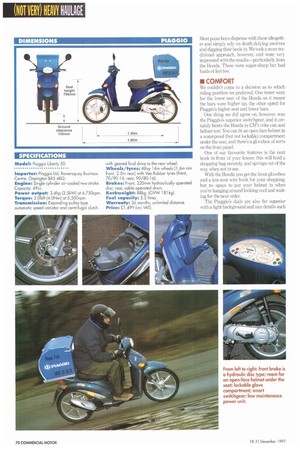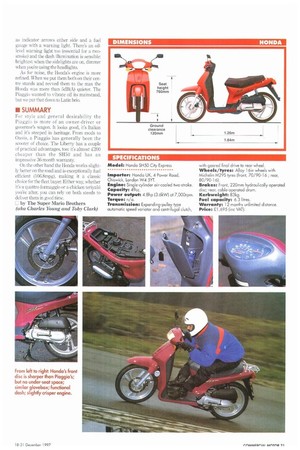Pizza Brothers
Page 71

Page 72

Page 73

If you've noticed an error in this article please click here to report it so we can fix it.
It used to be so simple. One week you were a car driver, the next you were pounding the highways in a fully freighted 38-tanner. Nowadays it's a theory paper first, followed by the rigid test. But things could get tougher still: rumoured EU regulations will soon require a would-be haulier to do a six-month stint delivering the smallest cargo of them all...PIZZAS.
And so it was that we found ourselves at Chobham on a cold November day with some hot pizzas and a couple of rather tepid pizza delivery bikes. These came courtesy of the two biggest names in the market: Honda with its plain SH50, and Piaggio with the more stylish Liberty. We had some prior experience of pizza bikes (one of our news team actually runs one) so we knew neither would set the blood racing. Nevertheless, we were determined to put them through their paces; the only question was—how?
These 50cc two-strokes are classed as mopeds and are limited to around 30mph, so the Scottish route was ruled out, but speed is still the overriding factor in pizza delivery. After all it's common knowledge that you get yer Hawaiian for nowt if it turns up late.
So the first test was a timed lap of the cir• cuit including the twisty handling section. We didn't have a calendar so for timing purposes we made do with a stopwatch. The test also involved running from the shop, starting the bike up and parking the bike and handing over the pizza on completion; a sort of Le Mans start (and finish) for quiet folk.
• PRODUCTIVITY
A pizza bike without a box is as much use as a naked chassis cab: of the two contenders, only Piaggio has put any thought into the bodywork.
The Honda has nothing better than a couple of bungee hooks under the seat, which would leave a pizza exposed and cooling rapidly. Aftermarket boxes are available, but Piaggio has developed a purpose-made system.
A sturdy, welded aluminium rack is mounted behind the single seat, and a box made of polypropylene (a sort of plastic corrugated cardboard) sits on top. This is light, windproof and (vitally) easily replaced. It's good to see that specifications are taken so seriously even at this end of the commercial market.
It was tricky to assess fuel consumption—a five-litre tank allows a fair bit of measurement error—but the Honda seemed to be much more frugal, delivering over 100mpg on one run. The low-mileage Piaggio, with a bulkier rider and a box on the back, struggled to better 65mpg.
• HANDLING
Both these bikes are absurdly easy to ride: there's an electric start, a twistgrip throttle and a brake lever on each bar. That's it. No clutch, no gears, no worries.
The first thing that became apparent was their very different handling characteristics. We had expected the Honda to be a paragon of Japanese stability while the Piaggio would be twitchy and full of Italian character. Not so. The SH50 turned out to be Mr Twitchy, but in a good way. Changing direction was just a case of er, twitching a certain part of the human anatomy. Suffice to say that driving by the seat of your pants has never been more easy, or more accurate.
The Liberty, on the other hand, took more of an effort to turn, possibly due to its fractionally longer wheelbase, but felt incredibly stable in a straight line. You can get used to cornering; countersteering leans the Liberty over quite nicely but the difference really shows up when it comes to turning the things round. The Honda can be pivoted on the proverbial 50 pence while the Piaggio needs the older, larger 50 pence.
• PERFORMANCE
But it wasn't cornering that helped the SH50 beat the Liberty round the lap (which it did convincingly): the Honda's straight-line performance was slightly better. In our "beating the lights" test we tried to replicate a pizza boy's Grand Prix reactions over about 50 metres: the Honda was 0.24sec faster, which doesn't seem important but feels much nippier. In its favour the Piaggio was far less run in with 120 miles on the clock against the Honda's 900 miles.
We weren't sure whether they would make it up Chobham's one-in-four test hill but there was a hungry man at the top so we gave it a go. The engine note went down initially and then kept going down, but eventually it levelled out and we just made it up on both bikes. Only just however: had he ordered a Meat Feast rather than a Marguerita we might well have struggled.
To be fair. Piaggio insists that the Liberty can be stopped and restarted on a 20% (1-in-5) gradient when fully laden.
The final performance test was the brakes.
Most pizza boys dispense with these altogether and simply rely on death-defying swerves and digging their heels in. We took a more traditional approach, however, and were very impressed with the results—particularly from the Honda. These were super-sharp but had loads of feel too.
• COMFORT
We couldn't come to a decision as to which riding position we preferred. One tester went for the lower seat of the Honda as it meant the bars were higher up: the other opted for Piag,gio's higher seat and lower bars.
One thing we did agree on, however, was the Piaggio's superior switchgear, and it certainly beats the Honda in GMs coke can and helmet test. You can fit an open-face helmet in a waterproof (but not lockable) compartment under the seat, and there's a glovebox of sorts on the front panel.
One of our favourite features is the neat hook in front of your knees: this will hold a shopping bag securely, and springs out of the way when not in use.
With the Honda you get the front glovebox and a low-rent wire hook for your shopping, but no space to put your helmet in when you're hanging around looking cool and waiting for the next order.
The Piaggio's dials are also far superior with a light background and nice details such as indicator arrows either side and a fuel gauge with a warning light. There's an oillevel warning light too (essential for a twostroke) and the dash illumination is sensible: brightest when the sidelights are on, dimmer when you're using the headlights.
As for noise, the Honda's engine is more refined. When we put them both on their centre stands and revved them to the max the Honda was more than 5d13(A) quieter. The Piaggio wanted to vibrate off its mainstand, but we put that down to Latin brio.
• SUMMARY
For style and general desirability the Piaggio is more of an owner-driver or governor's wagon. It looks good, it's Italian and it's steeped in heritage. From mods to Oasis, a Piaggio has generally been the scooter of choice. The Liberty has a couple of practical advantages, too: it's almost £200 cheaper than the SH50 and has an impressive 36-month warranty.
On the other hand the Honda works slightly better on the road and is exceptionally fuel efficient (106.8mpa making it a classic choice for the fleet buyer. Hither way, whether it's a quattro formaggio or a chicken teriyaki you're after, you can rely on both steeds to deliver them in good time.
by The Super Mario Brothers (aka Charles Young and Toby Clark) SPECIFICATIONS Model: Piaggio Liberty 50.
Importer: Piaggio Ltd, Ravensquay Business Centre, Orpington BR5 4BG.. Engine: Single-cylinder air-cooled two-stroke. Capacity: 49cc. Power output: 3.4hp (2.5kW) at 8,750rpm. Torque: 3.0114t (4.0Nm) at 5,500rpm. Transmission: Expanding-pulley type automatic speed variator and centrifugal clutch with geared final drive to the rear wheel. Wheels/tyres: Alloy 16in wheels (1.6in rim Front, 2.5in rear) with Vee Rubber tyres (front, 70/90-16; rear, 90/80-16).
Brakes: Front, 220mm hydraulically operated disc; rear, cable-operated drum. Kerbweight: 88kg, (GVVV 181kg). Fuel capacity: 5.5 litres.
Warranty: 36 months, unlimited distance. Price: £1,499 (inc VAT). SPECIFICATIONS Model: Honda SH50 City Express Importer: Honda UK, 4 Power Road, Chiswick, London W4 5YT.
Engine: Si rig e-cylinder air-cooled two-stroke. Capacity: 49cc Power output: 4.8hp (3.6kW) at 7,000rpm. Torque: n/a.
Transmission: Expanding-pulley type automatic speed variator anti centrifugal clutch, with geared final drive to rear wheel. Wheels/tyres: Allay 16in wheels with Michelin M29S tyres (front, 70/90-16; rear, 80/90-16).
Brakes: Front, 220mm hydraulically operated disc; rear, cable-operated drum. Kerbweight: 83kg Fuel capacity: 6.3 litres.
Warranty: 12 months unlimited distance. Price: £1,695 (inc VAT).












































































































































